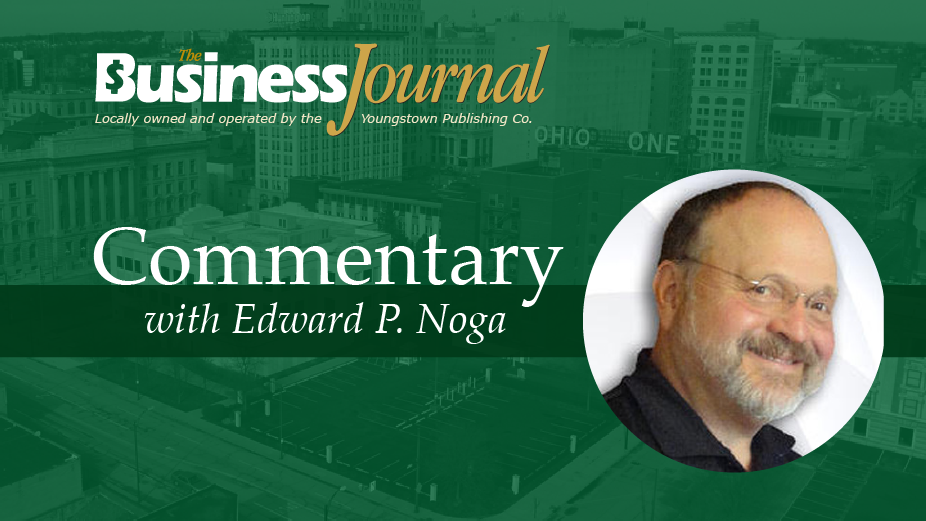By Edward P. Noga
YOUNGSTOWN, Ohio – As a baby boomer born in 1949 and growing up in the 1950s, I was totally taken in by model trains that overflowed store shelves.
The bonus of this experience was living across the street from Mr. Lowry (grandfather of Bill Lawson, executive director of the Mahoning Valley Historical Society), whose basement was, literally (and I do mean literally) covered with a raised platform of trains, trains and more trains.
His display was so large that he built hinged portal doors so he could maneuver beneath the platform and work on the display houses, buildings and movable accessories that made the area come alive. What a delight for anyone who came down to the basement with eyes wide and jaws dropped.
Of special interest were the switches that allowed a train to leave one set of tracks and enter an entirely new area of the display.
As I grew up, my fascination with railroad switches grew as I sat in the back seat of our station wagon (with real wood panels on the side doors) and traveled around the Mahoning Valley with my mom, dad and sister.
Remember, I grew up in an era when our Valley was the fourth-largest steel-producing area in the country. Railroad tracks covered the Valley. Trains making deliveries and picking up finished steel products were a constant presence.
At various intersections, the large switches were mesmerizing as they switched tons and tons of product and moving machinery onto different courses. And often, if we were stopped at a railroad crossing and got to witness the switch, the precision of the move seemed effortless, even though I realize now that such a switch was a highly calculated and precise move.
In these days of many moving parts and technological advances, I find it interesting that there is a move to appreciate and supply different infrastructure for moving people and goods. The reality of train use has mostly weathered the advances in transportation, while truck traffic has greatly increased.
As we work our way through better care of our planet and energy use, we have made some major shifts or switches as to how we live and how we move around. For instance, we are witnessing the appearance of roadways, bikeways and walkways that remind us that even though our automobiles remain a huge part of our travel and livelihood, we also need to make room for walking, bike riding, ride-sharing, and bus riding as part of the daily experience.
I love the freedom to get in my car at any moment and appreciate its importance in so many aspects of my life and daily activities. But I think we are learning to make a dedicated effort to be sensitive to the Switch (if I may use this as a homophone) that helps move people in other ways. Some studies indicate that about one in five millennials say they could live without access to a car.
This statistic seems more relevant to larger cities. But there might be a message for us as well. Some respondents cite congestion and the high cost of ownership. The same studies indicate that possibly one in 10 Gen-X respondents feel the same way.
My boomer generation is a single-digit percentage point feeling this way. Other contributing factors include ride-sharing and consistent flexibility of mass transit as demographics shift in our nation.
Currently, our local mass transit system boasts that almost half of its daily ridership is job-related. Over the years, those who monitor and adjust the Western Reserve Transit Authority routes have been keenly aware that companies moving into any region usually ask whether mass transit is available. In their own corporate ways, they seem to be aware of a possible switch.
In days past, the switchman (unsurprisingly) was the name given to the railroad employee who made the switch happen. Today, in some ways, each of us is the switchman who contributes to making the changes needed in our society.
I have been blessed to go across the pond twice in my life. My first venture was to my ancestral homeland in the Tetra Mountain region of Slovakia. I was also able to visit Rome and Vatican City to take in the religious center of my faith.
It was interesting to be on crammed buses and trains and to be part of evenings in central squares filled with bikers and walkers. The engaging experience certainly brings one into closer contact with humanity.
Although we will always be wedded to the invention that Henry Ford popularized, the speed of auto travel precludes taking in so much of what surrounds us and with whom we share this planet.
The next time you are near or stopped at a rail crossing, awaiting a train coming down the track, think of the switches we are making in our world. Hopefully, they are switches that put us on a set of tracks that are more inclusive and more concerned with what and whom is around us.
